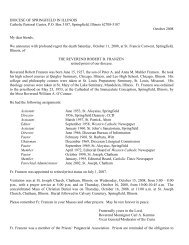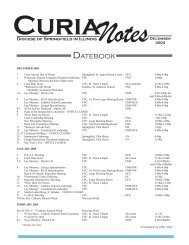Eucharistic Prayers for Masses with Children - Monthly Mailing ...
Eucharistic Prayers for Masses with Children - Monthly Mailing ...
Eucharistic Prayers for Masses with Children - Monthly Mailing ...
You also want an ePaper? Increase the reach of your titles
YUMPU automatically turns print PDFs into web optimized ePapers that Google loves.
Directory <strong>for</strong> <strong>Masses</strong> <strong>with</strong> <strong>Children</strong><br />
November 1, 1973<br />
Congregation <strong>for</strong> Divine Worship<br />
Introduction<br />
1. The Church must show special concern <strong>for</strong> baptized children who have yet to be fully initiated through the<br />
Sacraments of Confirmation and Eucharist as well as <strong>for</strong> children who have only recently been admitted to Holy<br />
Communion. Today the circumstances in which children grow up are not favorable to their spiritual progress. [1]<br />
In addition parents sometimes scarcely fulfill the obligations they accepted at the Baptism of their children to<br />
bring them up as Christians.<br />
2. In the upbringing of children in the Church a special difficulty arises from the fact that liturgical celebrations,<br />
especially the Eucharist, cannot fully exercise their inherent pedagogical <strong>for</strong>ce upon children. [2] Although the<br />
vernacular may now be used at Mass, still the words and signs have not been sufficiently adapted to the capacity<br />
of children.<br />
In fact, even in daily life children do not always understand all their experiences <strong>with</strong> adults but rather may find<br />
them boring. It cannot there<strong>for</strong>e be expected of the liturgy that everything must always be intelligible to them.<br />
Nonetheless, we may fear spiritual harm if over the years children repeatedly experience in the Church things that<br />
are barely comprehensible: recent psychological study has established how profoundly children are <strong>for</strong>med by the<br />
religious experience of infancy and early childhood, because of the special religious receptivity proper to those<br />
years. [3]<br />
3. The Church follows its Master, who "put His arms around the children . . . and blessed them" (Mk 10:16). It<br />
cannot leave children in the condition described. Vatican Council II had spoken in the Constitution on the Liturgy<br />
about the need of liturgical adaptation <strong>for</strong> various groups. [4] Soon afterwards, especially in the first Synod of<br />
Bishops held in Rome in 1967, the Church began to consider how participation by children could be made easier.<br />
On the occasion of the Synod, the President of the Concilium <strong>for</strong> the Implementation of the Constitution on the<br />
Liturgy said explicitly that it could not be a matter of "creating some entirely special rite but rather of retaining,<br />
shortening, or omitting some elements or of making a better selection of texts." [5]<br />
4. All the details of <strong>Eucharistic</strong> celebration <strong>with</strong> a congregation were determined in the General Instruction of the<br />
revised Roman Missal published in 1969. Then this Congregation began to prepare a special Directory <strong>for</strong> <strong>Masses</strong><br />
<strong>with</strong> <strong>Children</strong>, as a supplement to the General Instruction. This was done in response to repeated petitions from<br />
the entire Catholic world and <strong>with</strong> the cooperation of men and women specialists from almost every nation.<br />
5. Like the General Instruction of the Roman Missal, this Directory reserves some adaptations to the conferences<br />
of bishops or to individual bishops. [6]<br />
Some adaptations of the Mass may be necessary <strong>for</strong> children in a given country but cannot be included in a<br />
general directory. In accord <strong>with</strong> the Constitution on the Liturgy art. 40, the conferences of bishops are to propose<br />
such adaptations to the Apostolic See <strong>for</strong> introduction into the liturgy <strong>with</strong> its consent.<br />
6. The Directory is concerned <strong>with</strong> children who have not yet entered the period of preadolescence. It does not<br />
speak directly of children who are physically or mentally handicapped, because a broader adaptation is sometimes<br />
necessary <strong>for</strong> them. [7] Nevertheless, the following norms may also be applied to the handicapped, <strong>with</strong> the<br />
necessary changes.<br />
7. The first chapter of the Directory (nos. 8-15) gives a kind of foundation by considering the different ways in<br />
which children are introduced to the <strong>Eucharistic</strong> Liturgy. The second chapter briefly treats <strong>Masses</strong> <strong>with</strong> adults in<br />
<strong>Masses</strong> <strong>with</strong> <strong>Children</strong> – page 2 of 11.







